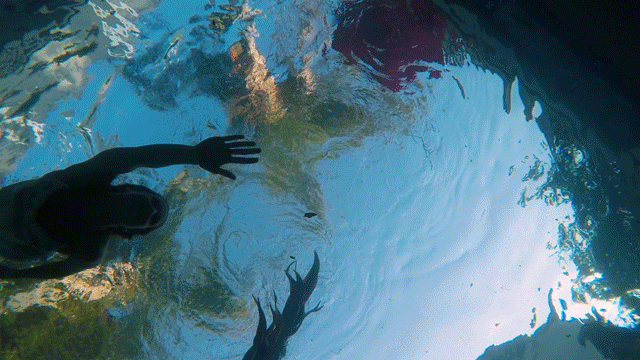Take These Tips From 3 Mermaids on How to Cast a Net for Your Dream Career

Every mermaid has her tale.
Hannah Fraser, Linden Wolbert and Marina Anderson may all be sirens of the sea, but each has her own hook for making money as a real-life mermaid.
Anderson swims in a mermaid show every weekend; Fraser creates living art as a mermaid model; and Wolbert teaches about the seas through live appearances and her YouTube videos.
(They’re not the only ocean enchantresses raking in the clams — here’s a tale of Florida’s Weeki Wachee mermaids.)
This trio of sea sprites was willing to help us land dwellers with eight tips for turning that far-fetched fantasy into a real career.
1. Build to Scale

Fraser says she was obsessed with mermaids as a kid growing up in Australia and convinced her mom to transform her into a real-life mermaid — sort of.
“My mom helped me create this first mermaid tail, which was totally non-functional,” says Fraser, who now lives in Los Angeles. “It was basically like tying your legs together and putting pillow stuffing on the end.”
Fraser admits her enthusiasm for the tail could have ended in disaster if it hadn’t been for sheer determination — and a strong swim stroke.
“I don’t know why [my mom] thought it would be OK for me to jump in the pool — maybe she didn’t even know — but I was just ready to go for it,” Fraser says. “It was a great sink-or-swim moment, and I learned how to swim really, really well.”
Today, Fraser has 14 tails — each one designed for a specific use, such as photography, film or live appearances.
2. Be Prepared to Say ‘No Flipping Way’

Performing as Mermaid Linden at public events, birthday parties and schools, Wolbert promotes herself as an “ocean edutainer,” teaching kids about aquatic animals and promoting conservation.
Defining her brand and values early in her career helped her stand strong against a tide of monetary temptations, according to Wolbert, who’s based in Los Angeles.
“I could have done a ton of creepy bachelor parties that were not anywhere near my G-rated, geeky science mermaid persona — and made a lot of money,” she Wolbert. “But guess what? I turned them all down because that’s not me.
“It is not in my heart, and it doesn’t help educate kids about the ocean.”
3. Hold Your Breath

Anderson recognized the potential for her aquatic show when she visited the nautical-themed Wreck Bar in Fort Lauderdale, Florida.
The hotel bar featured windows that offered underwater views into the pool — ideal for a mermaid show.
She pitched the idea in 2006 and gave a demo performance. The hotel turned her down but offered to let her practice in the pool.
She considered it an opportunity to prove the doubters wrong.
“Every Thursday at 5:30, I’d be here. I started advertising it… ‘Come watch a mermaid swim through the portholes,’” Anderson says. “Within two months, the bar was full… and then the hotel reconsidered.”
The hotel hired her, and she’s performed in the bar’s weekend aquatic show ever since.
4. Go With the Flow

Fraser’s Plan A for her career wasn’t to be a mermaid but to draw them as a fantasy artist.
It took getting cast in an underwater modeling shoot for her to realize that her swimming skills opened up opportunities beyond the canvas.
“I didn’t think that I had a special talent,” Fraser says. “But then I realized that everybody else kind of looks like dying blowfish under the water, and it was my happy place.”
Fraser has since gone on to appear in more than a dozen television shows and films, including the 2010 Oscar-winning documentary “The Cove.”
“It wasn’t until I did that modeling job where I had the a-ha moment,” Fraser says. “I realized, ‘Oh, I am the fantasy creature — I don’t need to draw it.’”
5. Diversify Your (Revenue) Streams

Everything was going swimmingly for Wolbert back in 2012 when she started producing an educational series, “Mermaid Minute,” on her YouTube channel.
“YouTube used to be a great source of income for me,” says Wolbert. “I was doing four digits a month.”
She even funded her second season of the series via a Kickstarter campaign that raised more than $26,000.
But the tides, they were a-changin’.
“I don’t want to diss YouTube and Google, but they changed their algorithms, and it’s become a lot more challenging,” says Wolbert, who notes that YouTube’s stricter monetizing requirements left her funding the videos out of pocket.
Instead of drowning her sorrows, she diversified her income through other ventures, including developing a Mermaid Linden Mono Fin by Body Glove in 2013 and making live appearances in her mermaid tail.
“Lots of different facets of income diversification — that is key for me,” she says.
6. Increase Your Net Worth

Mermaiding isn’t all lazy lagoons and dancing with dolphins.
Although it might not be the part of a job she dreamed about, Fraser says learning business skills like budgeting, marketing and negotiating has allowed her to plot her own course to success.
“There’s a lot of people who want to say, ‘Oh, let me manage you, and you just be the pretty mermaid girl,’” Fraser says. “But that’s the times I’ve gotten into trouble — when I give over the reins to somebody else.”
7. Own Your Ursula

Not everyone’s underwater fantasy fits the stereotype.
Due to the popularity of a certain Disney princess, mermaids tend to get swept into the sweet-and-innocent crowd — unless you hang with the fiery Anderson.
She puts on family-friendly shows early in the day at the Wreck Bar, but for the late shows, she stages an aqua burlesque.
And while Anderson might gamely field questions about Ariel for the little girls, she argues that a certain villain was in a much happier place, careerwise.
“Ariel doesn’t want to be a mermaid — you want to be somebody who hates doing what she does?” Anderson says with a laugh. “Ursula liked being herself — the drag queen likes to be herself, is comfortable in her body.”
8. Just Keep Swimming

There aren’t any colleges that offer majors in mermaiding (yet), so Wolbert’s path to a fin-tastic career required plenty of determination.
“You have to have this vision that is so clear,” says Wolbert. “Follow it with every bit of tenacity and passion and positivity and optimism you can.
“You’re going to have barriers … you’re going to have people who are pessimists.”
So how does a mermaid keep her head above water?
“The more you believe in yourself, the more likely your dreams will be realized,” Wolbert says. “So surround yourself with people who believe in you and help you, nurture you, bolster you up — even on the days when you feel like quitting.”
Perhaps that’s why these three make such a happy pod.
Tiffany Wendeln Connors is a staff writer at The Penny Hoarder. She loves to shell-ebrate good times. C’mon.
















